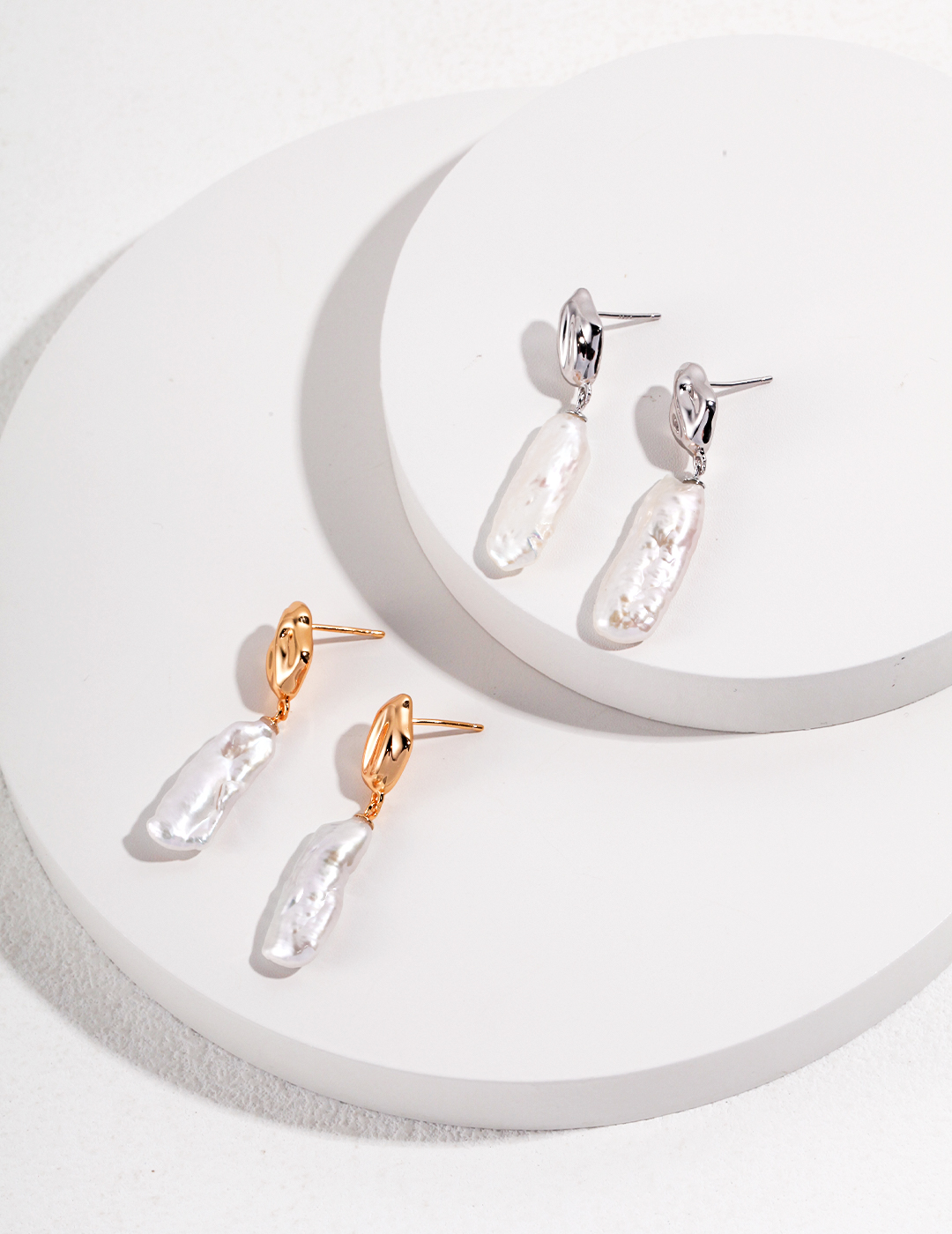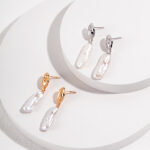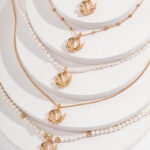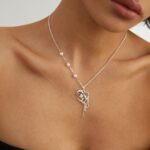The history of natural pearl jewelry is extensive & goes back many centuries. Pearls are a symbol of refinement & elegance that have long been prized for their beauty and rarity. This essay will examine the background of natural pearl jewelry as well as the distinctive qualities of various varieties of natural pearls. Since ancient times, people have appreciated pearls for their beauty. Pearls were first known to be used as jewelry in ancient Egypt, when they were worn by nobles and members of the royal family.
Pearls were widely used to embellish garments and accessories in ancient Rome because they were regarded as the ultimate status symbol. When an irritant, like a sand grain or a parasite, gets inside an oyster or mollusk, natural pearls are created. The oyster produces layers of nacre—a calcium carbonate & protein mixture—in reaction to the irritant in order to coat it and form a pearl. The resilient oyster and the splendor of nature are both exemplified by the pearl that is produced after this sometimes multi-year process.
Natural pearls come in various varieties, each having special qualities of its own. The most famous kind, known as a saltwater pearl, is created by oysters that are found in the ocean. Each type of saltwater pearl has its own unique color & size, and they can be further divided into Akoya, Tahitian, and South Sea pearls. Usually white or cream in color, akaiya pearls are prized for their shine.
Classic pearl necklaces and earrings frequently feature them. Conversely, Tahitian pearls are valued for their size and distinctive overtones and come in a variety of colors, including black, gray, and green. The largest type of pearls are South Sea pearls, which are distinguished by their golden tones. Freshwater pearls, which are formed in mussels that inhabit rivers, lakes, & ponds, are in addition to saltwater pearls. Freshwater pearls are widely used in more modern & distinctive jewelry designs because they are available in a wide range of shapes and colors.
| Aspect | Metric |
|---|---|
| Storage | Keep pearls in a soft pouch or cloth bag to prevent scratches |
| Cleaning | Wipe pearls with a damp cloth after each use to remove oils and dirt |
| Chemicals | Avoid exposing pearls to chemicals such as perfume, hairspray, and cleaning products |
| Temperature | Avoid exposing pearls to extreme temperatures or direct sunlight |
| Restringing | Have pearls restrung every 1-2 years to prevent breakage and ensure security |
A number of factors affect the value of natural pearls. The pearl’s rarity is the most significant factor. Because they arise naturally by accident, natural pearls are extremely rare. Because they are so uncommon, they are extremely valuable and sought after.
The size of natural pearls also has an impact on their value. Due to their rarity, larger pearls are usually more valuable. A pearl’s value is also influenced by its shape.
Pearls with irregular shapes are regarded as less valuable, whereas round pearls are the most sought-after and fetch higher prices. An additional crucial element in assessing a pearl’s value is its luster. The reflection of light off a pearl’s surface is referred to as luster. Due to their radiant glow and more vivid appearance, pearls with a high luster are valued higher.
There are some significant distinctions between cultured and natural pearls that should be taken into account. The method used to produce cultured pearls is known as pearl farming, in which an irritant is inserted into an oyster or mussel to encourage the development of a pearl. Cultured pearls are not as rare & therefore not as valuable as natural pearls, even though they can still be just as beautiful. To preserve their value and beauty, natural pearls need special handling.
Since pearls are organic, they are more easily harmed by heat, chemicals, and even the oils on our skin than other gemstones. To ensure the longevity of natural pearl jewelry, it is crucial to handle it carefully and take the appropriate safety measures. Natural pearls need special care because they are delicate, which is one of the main reasons. Pearls are easily scratched or chipped due to the fragility of the nacre layers that make them up. Wearing pearl jewelry while participating in activities like sports or housework could potentially harm the pearls. Preserving the natural color of pearls is another reason why proper maintenance is essential.
Because pearls are porous, they can take in chemicals from their surroundings, including sweat, lotions, and perfumes. Over time, these substances may cause the pearls to become dull and lose their luster. Pearl jewelry should not be exposed to chemicals, and it should be cleaned frequently to get rid of any accumulation. To prevent damage to natural pearl bracelets, proper cleaning methods and a delicate touch are necessary.
Here is a detailed tutorial on cleaning bracelets made of natural pearls:1. Make a mild cleaning solution first. In a small bowl, combine a few drops of mild dish soap with warm water. 2. Clean makeup brushes or soft, lint-free cloths should be dipped into the cleaning solution.
Wipe the pearls gently, making sure to get rid of any residue or dirt. 3. In order to get rid of any soap residue, rinse the pearls under clean water. Use a light stream of water and take care not to fully submerge the pearls. 4. Using a gentle, spotless cloth, pat the pearls dry. Pearls can become brittle if they are dried using a hairdryer or any other heat source. 5. In order to prevent scratches, once the pearls have dried, store them in a jewelry box or a soft pouch.
Natural pearls should never be cleaned with harsh chemicals like bleach or ammonia because they can irreparably damage the stone. It is best to use gentle, non-abrasive cleaning products when caring for natural pearls. In order to clean and restore the luster of pearls, there are also specialist cleaning solutions on the market. When applied to real pearls, these solutions are safe & gentle.
The integrity and beauty of freshwater pearl rings must be preserved through proper storage. The following are some recommended methods for keeping freshwater pearl rings: 1. Freshwater pearl rings should be kept out of direct sunlight in a cool, dry place. Pearls can lose their luster and turn discolored when exposed to heat and sunlight. 2. Pearls can get damaged if they are kept in airtight containers, which is why it’s best to avoid doing so. Rather, keep them in a jewelry box lined with soft fabric or a soft pouch. 3.
Pearl rings should be kept apart from other jewelry to avoid scratches. Given their soft nature, harder gemstones or metals have the potential to easily damage pearls. 4. The moisture in the air can cause pearls to become dull and lose their luster, so avoid keeping pearl rings in places with high humidity, like bathrooms. 5. A soft, lint-free cloth should be used to gently wipe your pearl rings in order to remove any dirt or residue. Periodically checking on your pearl rings is also a good idea.
A common mistake that can cause damage should be avoided when storing freshwater pearl rings. Pearl rings stored in plastic bags are prone to chemical emissions that could damage the pearls, which is a common mistake. Another mistake is trying to clean the pearls with abrasive materials or strong cleaning agents, which can scratch the pearls’ surface.
A timeless and classic piece of jewelry, pearl earrings can make any outfit seem better. Here are some pointers to keep pearl earrings bright and glossy:1. Steer clear of harsh chemicals like lotions, hairsprays, & perfumes when wearing pearl earrings. These materials have the potential to discolor and lessen the pearls’ brilliance. 2.
Waiting a few minutes after using any beauty products to give them time to dry completely is a good idea before wearing pearl earrings. This will lessen the possibility of any residue getting in contact with the pearls. Three.
Use a clean makeup brush or a soft, lint-free cloth to gently wipe away any dirt or residue when cleaning pearl earrings. The pearls may get damaged if harsh chemicals or abrasive materials are used. 4. To prevent getting oils and dirt on the pearls, it’s crucial to handle pearl earrings with clean hands. Wash your hands, if needed, before handling pearl earrings. 5. To prevent scratches, pearl earrings should be kept in a jewelry box or a soft pouch when not in use.
Keep them out of places with excessive humidity or cold. It’s crucial to stay away from specific behaviors in order to protect pearl earrings. Wearing pearl earrings while showering or swimming is a common mistake that pearls can break from the saltwater and chlorine. Pearl earrings can get scratched if they are kept in a jewelry box without enough padding or compartments. This is another common mistake.
An elegant piece of jewelry that can be passed down through the generations is a classic pearl necklace. Following these suggestions will help you store & maintain a classic pearl necklace:1. To remove any oils or dirt, gently wipe the pearl necklace after wearing it with a soft, lint-free cloth. This will assist in avoiding any accumulation that might cause the pearls’ luster to fade. 2.
Steer clear of harsh chemicals like lotions, hairsprays, and perfumes when wearing a pearl necklace. These materials have the potential to tarnish and dull pearls. 3. A jewelry box or a soft pouch lined with soft fabric are good places to keep pearl necklaces when not in use. Keep it away from places with high humidity or very cold temperatures as these can discolor and dull the pearls. 4. To keep the silk thread from stretching or breaking, it’s crucial to occasionally re-string a pearl necklace. A qualified jeweler with experience in creating pearl jewelry should do this. 5.
A pearl necklace should not be worn when participating in activities like sports or housework that could potentially harm the pearls. Pearls are delicate & prone to chipping or scratching. It’s crucial to understand common problems that might occur and how to prevent them when taking care of a classic pearl necklace. A frequent problem is the silk thread holding the pearls together stretching or breaking.
It’s crucial to have the necklace periodically re-stringed by a qualified jeweler to avoid this. The dulling of luster with time is another problem. Regular cleaning and proper storage are essential for preserving the luster of a pearl necklace.
To prevent damaging the pearls, cleaning jewelry made of natural pearls calls for caution & the appropriate cleaning methods. When cleaning natural pearl jewelry, keep in mind these common cleaning errors:1. Using abrasive chemicals: Natural pearls can sustain irreversible damage from the use of harsh chemicals like ammonia or bleach.
It’s crucial to keep these materials away from pearl jewelry cleaning. 2. Using abrasive materials: Pearls’ surface can be scratched by abrasive materials like toothbrushes and scrubbing pads. Pearl jewelry is best cleaned gently with a clean makeup brush or a soft cloth free of lint. 3. The silk thread that holds pearls together can become weaker if they are submerged in water, so it is best to avoid doing this. To rinse the pearls without getting the silk thread wet, use a light stream of water instead. 4. Using too much force: Pearls are delicate & easily harmed by too much force.
When cleaning or handling pearl jewelry, it’s crucial to exercise caution and not use excessive pressure. 5. Improper pearl drying: It’s crucial to pat dry pearl jewelry using a gentle, clean cloth after cleaning it. The pearls can get brittle if you try to dry them with a hairdryer or any other heat source. It’s crucial to use gentle cleaning agents and follow the right cleaning procedures to prevent damage to natural pearls.
For advice on how to maintain and clean your particular piece, it’s a good idea to speak with a qualified jeweler who specializes in pearl jewelry. Although natural pearl jewelry can be kept beautiful with routine cleaning and care, professional maintenance may eventually be required. When it comes to natural pearl jewelry, the following situations should be looked after by professionals:1. Restringing: A pearl necklace or bracelet’s silk thread may stretch or break with time. It is crucial that the piece be restrung by a qualified jeweler with experience in pearl jewelry when this occurs.
In addition to ensuring that the pearls are safely held together, this will stop any additional damage. 2. Polishing: A skilled jeweler can bring back the shine and brilliance of natural pearls if they have become dull or lackluster. Improper polishing can cause damage to pearls, so this should only be done by a qualified expert with pearl-related experience. Three. Repairing: A qualified jeweler can fix a naturally occurring pearl that has chipped or been damaged. This could entail having the damaged pearl replaced or utilizing methods to hide the damage. 4.
Assessment: It’s best to have a piece of natural pearl jewelry evaluated by a specialist if you’re not sure of its worth or authenticity. The worth and caliber of the pearls can be accurately determined by an appraiser. Selecting a reliable jeweler with expertise in pearls is crucial when seeking maintenance for natural pearl jewelry. Choose a jeweler who can provide references or testimonies from happy clients and who has experience working with real pearls.
Finally, genuine pearl jewelry is a classy and classic piece of jewelry that will last for many generations. You can guarantee that your pearl jewelry will continue to be lovely and valuable for many years to come by learning about the origins and distinctive qualities of natural pearls as well as the significance of regular upkeep. Keep in mind to handle natural pearl jewelry carefully, keep it out of the sun & harsh chemicals, & clean it on a regular basis with gentle methods & supplies. In case of uncertainty, seek guidance and upkeep from an expert jeweler who specializes in pearl jewelry.
You can live a lifetime of natural pearl jewelry beauty & allure by adhering to these guidelines & taking the appropriate safety measures. Natural pearls are a living example of both the timeless beauty of fine jewelry and the wonders of nature. They make for stunning bracelets, elegant earrings, or classic necklaces.






